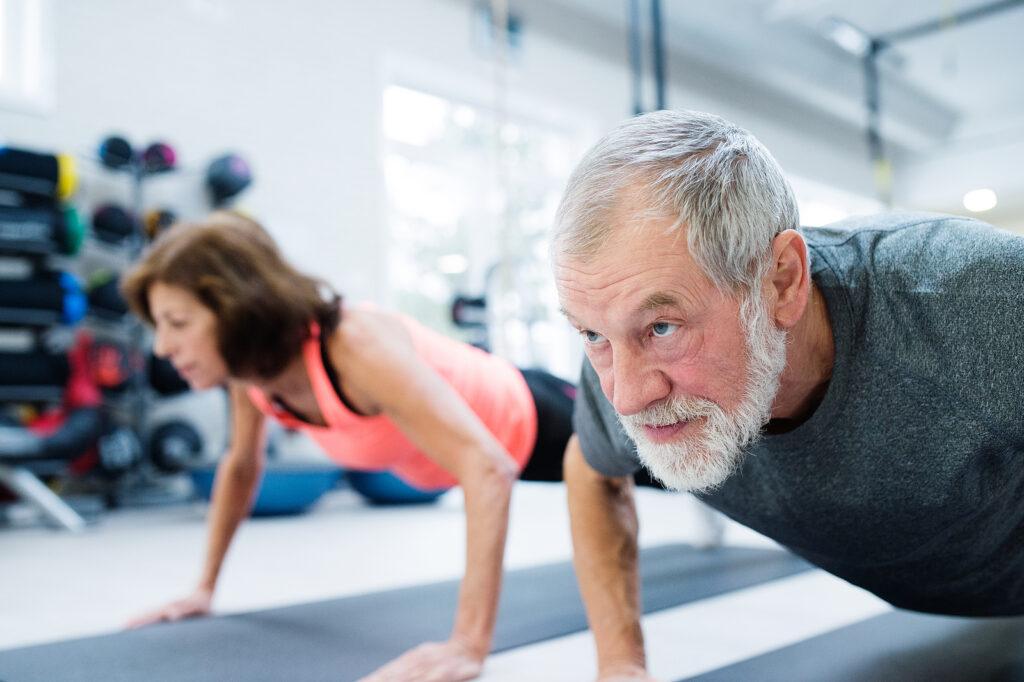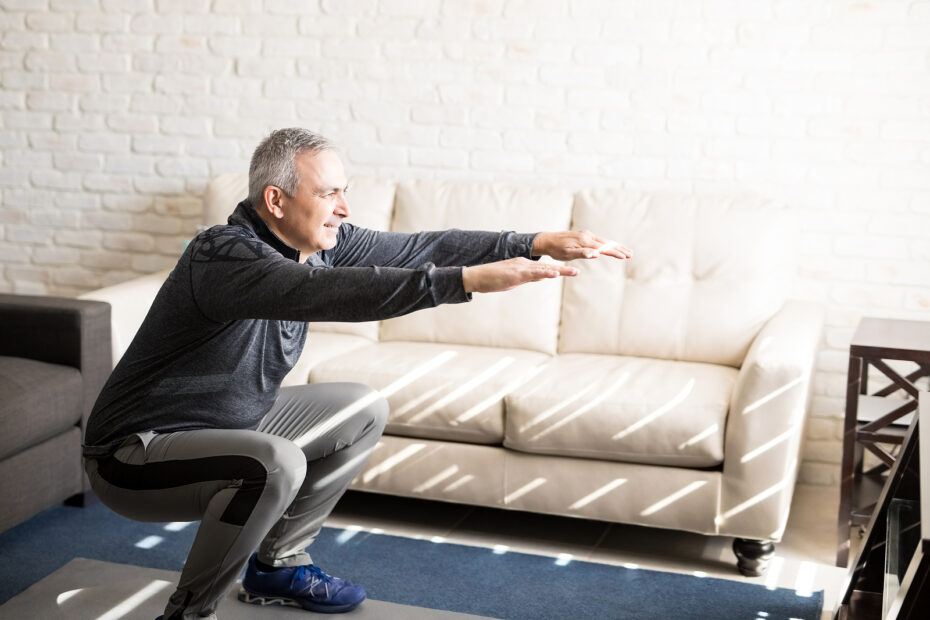Maintaining strength is one of the best things we can do for ourselves as we age, mostly because being stronger makes everything easier.
The problem though, is that it tends to become more challenging to exercise as we get older.
Which often results in seniors exercising less (or not at all) and developing significant mobility issues.
It can be a debilitating cycle, but isometric exercises can be a nice alternative when traditional strength training exercises are too painful or challenging.
These exercises involve holding a position or contracting muscles without movement, making them ideal for seniors looking to build strength with minimal joint stress.
In this guide, we’ll explore some of the most effective isometric exercises seniors can do from home, as well the benefits these exercises can offer.
We’ll also offer some tips and suggestions for incorporating them into a daily routine.
After reading, seniors and caregivers will know everything they need to in order to start trying these exercises on their own.
What Are Isometric Exercises?
Isometric exercises involve contracting muscles without changing their length or causing joint movement.
This means you hold a position, engaging specific muscle groups, without actual motion.
These exercises can help build strength and endurance, but without putting undue stress on joints – making them especially beneficial for seniors with arthritis, joint pain, or mobility concerns.
And it’s a bad idea to confuse isometric with “easy” because isometric exercises can as challenging as any isotonic exercise.
Isometric vs. Isotonic Exercises
To better understand isometric exercises, it’s helpful to compare them with isotonic exercises:
| Feature | Isometric Exercises | Isotonic Exercises |
|---|---|---|
| Muscle Movement | No movement (static hold) | Muscles shorten and lengthen (dynamic movement) |
| Joint Impact | Low (ideal for joint issues) | Higher (may stress joints) |
| Examples | Wall sit, plank, palm press | Squats, push-ups, bicep curls |
| Benefits | Improves muscle endurance, stability, and posture | Builds strength, endurance, and flexibility |
| Equipment Needed | Minimal or none | Often requires weights or resistance bands |
Benefits of Isometric Exercises for Seniors
Isometric exercises offer several advantages, including:
- Improved Muscle Strength – Helps maintain and build muscle without heavy lifting.
- Enhanced Joint Stability – Strengthens muscles around joints, reducing pain and risk of injury.
- Better Balance & Posture – Supports core strength, reducing the likelihood of falls.
- Lower Impact on Joints – No excessive movement, making them safer for seniors with arthritis or mobility issues.
- Convenience & Accessibility – Can be performed anywhere, often without equipment.
The 5 Best Isometric Exercises for Seniors
1. Wall Sit (for Leg Strength & Endurance)
The wall sit is a classic exercise and it’s used all the time from elite athletes to patients rehabbing after a knee replacement… and for every fitness level in-between.
This exercise is great because it works just about every muscle from the waist down and can easily be tailored to meet any fitness level.
It’s essentially an isometric squat, but the wall helps protect the back, making it a safe alternative.
How to Do It:
- Stand with your back against a wall, feet at least shoulder-width apart and slowly lower yourself into a seated position (as if sitting in an invisible chair).
- Hold this position for 15-30 seconds (or as long as comfortable).
- Slowly stand back up and repeat for 2-3 sets.
You can make this exercise more challenging by holding longer, or sitting into a deeper position, but just make sure you can stand back up.
And know that the deeper you go, the more stress it’ll put on your knees, so only go as far as is comfortable.
Helpful tip: make sure your feet are far enough away from the wall that your knees don’t pass over your toes when you squat down.
Click here for a video demonstration.
2. Isometric Wall Push-up (for Upper Body Strength)
Push-ups are one of the best upper body exercises because they target a lot of muscle groups and they don’t require any additional equipment.
It’s true, traditional push-ups can be challenging for seniors, especially ones with achy joints or who have difficulty getting down on the ground, but there are plenty of alternatives that can still work great.
And the isometric wall push-up is a prime example.
How to Do It:
- Stand in front of a wall and place both hands on the wall, roughly shoulder-width apart.
- Brace your core as you bend your elbows, bringing your face toward the wall.
- Hold this position for 15-30 seconds (or more) and then gently push back into the starting position.
- Repeat for 3-5 sets.
Feel free to play with hand placement to find a comfortable position for your shoulders and wrists (you can also do this exercise with a narrow push-up hand placement).
Helpful tip- the farther your feet are from the wall, the harder this exercise is going to be.
3. Wall Planks (for Core Strength)
The wall plank is a variation of the popular floor plank, which is known as being of the most effective core strengthening exercises out there.
FYI, floor planks are also isometric, so if you’re comfortable with getting down on the floor, feel free to try that exercise as well.
Planks of either variety are great because they strengthen a lot of the muscles in our cores, which help protect our back during daily activities.
How to Do It:
- Sit a couple of feet away from a wall, feet shoulder-width apart.
- Place forearms on wall, ensuring they are in line with shoulders.
- Engage core (pull in bellybuttons) and try to maintain straight back.
- Hold for 15 – 30 seconds (or more) and then rest.
- Repeat for 3-4 sets.
Focus on keeping your core and glutes tight and engaged during this exercise and don’t forget to breathe!
Click here for a demonstration video.
4. Isometric Shoulder Abduction (for Shoulder Strength)
This is a gentle exercise to help start strengthening the deltoids in the shoulders and it can be a good place to start for seniors with really weak arms or achy joints that limit mobility.
How to Do It:
- Sit or stand and bring both arms straight out to side, palms down.
- Hold arms out in this position for 30 – 60 seconds (or longer) and then rest.
- Maintain good upright posture and make sure your shoulder blades stay low.
- Repeat for 4-5 sets.
Helpful tip: you can make this exercise more challenging by increasing your hold time or holding a small dumbbell or can of soup (just keep in light because it doesn’t take much resistance to make this really hard).
5. Isometric Bridge (for Leg and Core Strength)
This exercise is a great way to strengthen the glutes, hamstrings, and lumbar extensors, as well additional hip and core stabilizers.
In other words, it works a lot of muscles.
But you have to be careful, because seniors with achy backs may find this one uncomfortable.
You also have to be comfortable lying on your back, but you can always do this exercise in bed too.
How to Do It:
- From a lying position, bring both feet up and place them about shoulder-width apart.
- Push through your feet, bringing your pelvis off the ground/bed.
- While maintaining a tight core, hold this position for 15 – 30 seconds (or longer).
- Slowly return back to a lying position and rest.
- Repeat for 3- 4 sets.
Feel free to play with foot placement to find a comfortable position; you can make this exercise more challenging by holding for longer periods or adding additional sets.
Click here for a video demonstration.

Additional Tips for Safe Isometric Exercise
Start Slow
When starting isometric exercises, it is essential to begin with shorter hold times and gradually increase them as strength and endurance improve.
Feel free to add additional resistance or attempt more challenging variations as your strength improves.
Proper Posture
Maintaining good posture is crucial to prevent unnecessary strain.
Make sure to maintain a neutral spine and avoid excessive tension in the neck or lower back during all exercises.
Breathe
Breathing properly is another key factor – never hold your breath during isometric exercises.
Instead, focus on steady inhaling and exhaling to maintain relaxation and muscle control.
And yes, you should be able to maintain a tight core without holding your breath!
Modify As Needed
If any exercise feels too difficult or causes discomfort, consider modifying the movement by using a chair or wall for extra support.
You can also try varying hand/foot placements to find a position that’s comfortable for you.
Regardless of the exercise, rest assured that it can be modified to fit seniors of all fitness levels.
And when in doubt, feel free to use a caregiver as a spotter for additional support.
Listen to Your Body
Listening to your body is essential – if you experience pain, dizziness, or unusual discomfort, stop the exercise immediately.
Strengthening exercises, especially isometric exercises, should never hurt!
It may be a simple issue of correcting your form or trying a slightly different position, but it could also mean that particular exercise isn’t appropriate.
When in doubt, feel free to consult with a healthcare provider or physical therapist for personalized guidance.
Final Thoughts
Isometric exercises are an excellent way for seniors to build strength and maintain overall mobility, without putting excessive strain on the joints.
These exercises are pretty simple, but they’re also effective.
And the fact that you can perform them anywhere makes them great for seniors working out at home.
When adding these exercises to your routine, it’s smart to start slow and gradually increase difficulty as tolerated.
And again, please don’t try to work through pain – that’s a bad idea.
Also, keep in mind that consistency makes all the difference in the world – it takes time to build stronger muscles.
Anyway, I hope you found this guide helpful and if you have any questions or comments, just leave ’em below and I’ll get back to you soon.



